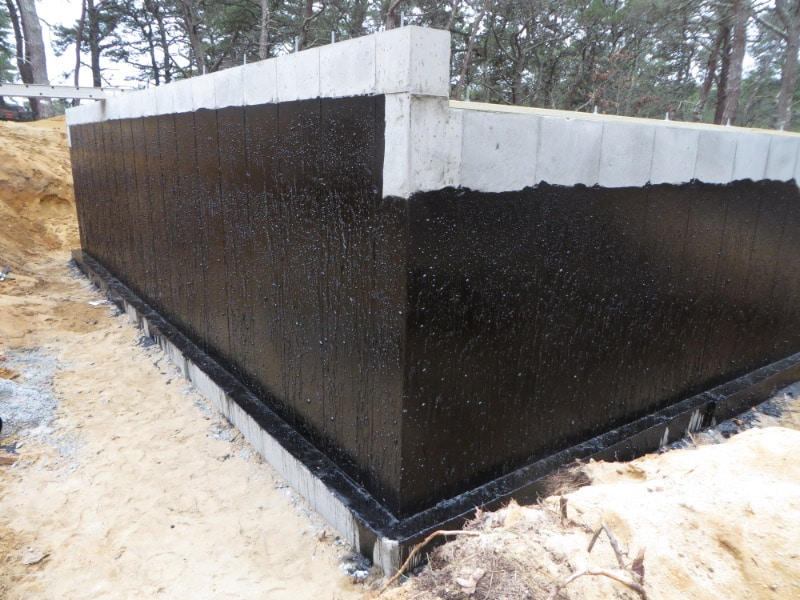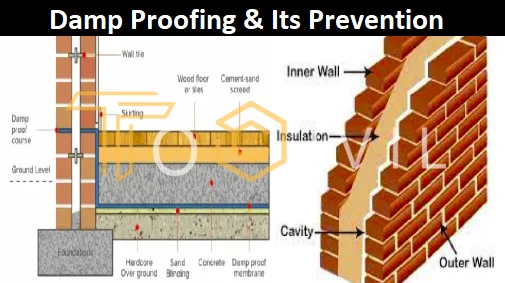How to spot early symptoms of rising damp: A must-read for landlords in damp proofing newcastle
Exploring the Different Techniques and Solutions for Effective Damp Proofing
Wetness in buildings positions substantial challenges to both architectural honesty and interior air top quality. Various methods and remedies have emerged to fight this prevalent problem. From standard damp-proof membranes to cutting-edge chemical therapies, each method uses one-of-a-kind benefits. Recognizing these choices is essential for effective wetness control. Nevertheless, picking the ideal option relies on particular structure conditions and demands, motivating further exploration right into the most efficient wet proofing approaches available.
Understanding the Reasons of Wetness
Although moisture can arise from numerous resources, comprehending these causes is crucial for reliable remediation. Frequently, moisture originates from three main resources: increasing damp, permeating moist, and condensation. Climbing damp happens when groundwater travels up through porous products, such as brick or rock, typically because of an absence of an effective obstacle (damp proofing newcastle). Penetrating moist is usually triggered by outside aspects, consisting of roof leaks, defective seamless gutters, or harmed wall surfaces, permitting water to penetrate a home. Condensation, on the various other hand, arises from excess wetness airborne, commonly exacerbated by inadequate air flow and temperature distinctions, resulting in water droplets developing on surfaces. Determining these underlying issues is important, as each kind of dampness requires a tailored strategy for removal. Correct assessment helps in identifying one of the most effective solutions, inevitably securing the architectural integrity of a structure and enhancing indoor air quality
Conventional Damp-Proof Membranes

Chemical Damp-Proofing Solutions
Chemical damp-proofing services provide an ingenious method to protecting against wetness breach in structures. These approaches usually include the application of liquid chemicals that permeate stonework and create an obstacle against rising wet. Commonly utilized chemicals consist of silanes, siloxanes, and other water-repellent representatives that respond with surface area materials to create a hydrophobic layer.The application procedure generally calls for exploration openings right into the walls, infusing the chemical solution, and allowing it to cure. This technique is specifically helpful for older structures where traditional damp-proof membrane layers might be impractical. Chemical damp-proofing can be much less disruptive and a lot more economical than extensive renovation projects.While efficient, these solutions depend on appropriate application and environmental problems for peak efficiency. mould treatment newcastle. Normal upkeep and surveillance are necessary to ensure the longevity of the damp-proofing therapy. Generally, chemical damp-proofing represents a functional option for safeguarding buildings versus moisture-related damage
Dental Caries Wall Surface Building And Construction Strategies
Cavity wall surface construction methods provide many benefits, specifically in wetness control and power efficiency. By integrating an air void between 2 layers of stonework, these wall surfaces effectively minimize water ingress while enhancing insulation. This combination not only protects frameworks from wetness yet likewise contributes to lowered energy usage.
Advantages of Cavity Wall Surfaces
When considering effective moist proofing approaches, the benefits of dental caries wall surfaces stick out plainly. Cavity wall surfaces are composed of 2 different layers, creating an air gap that efficiently decreases moisture penetration. This design lessens the danger of wetness, as the external wall surface functions as an obstacle against rainfall and water access. Additionally, tooth cavity wall surfaces enhance thermal insulation, which adds to power effectiveness by decreasing heat loss. They likewise supply sound insulation, helping to develop a quieter interior environment. In addition, the air gap enables ventilation, which assists in moisture control and lowers the probability of mold and mildew development. These advantages not just enhance the general convenience of a building but likewise add to its long life and structural integrity.
Moisture Control Methods
Reliable wetness control strategies are important in cavity wall surface building to assure long-lasting defense versus wetness. One primary method entails the unification of weep openings, which facilitate water drain from the cavity, protecting against accumulation. In addition, making use of breathable membranes can help manage dampness degrees while allowing trapped vapor to leave. Correct placement of insulation is likewise vital, as it must not obstruct water drainage paths. Making sure that the external leaves of the cavity wall are created with water-resistant products boosts total sturdiness. Normal maintenance checks are crucial to identify any obstructions or damages early, guarding the framework's honesty. Inevitably, a mix of these methods creates a robust protection versus wetness intrusion in tooth cavity walls.
Insulation and Energy Performance
Insulation plays an essential function in enhancing power efficiency within tooth cavity wall building and construction. By including shielding products, these wall surfaces produce a thermal obstacle that minimizes warm loss and minimizes energy consumption. Reliable insulation not only aids preserve a stable indoor temperature yet additionally mitigates the threat of wetness, as it avoids condensation within the wall cavity. Numerous strategies, such as the use of inflexible foam boards or mineral woollen, can be used to accomplish optimal insulation efficiency. In addition, appropriate installation is necessary to assure that voids and spaces are minimized, which can otherwise endanger energy effectiveness. Eventually, a well-insulated tooth cavity wall surface adds significantly to total sustainability and reduces home heating and air conditioning costs for house owners.
External Damp Proofing Techniques
External damp proofing approaches are crucial for protecting frameworks from wetness seepage. 2 reliable strategies include the application of water-proof membrane layers and the setup of French drains pipes. These services help mitigate water accumulation and protect the integrity of buildings.
Waterproof Membrane Application
While numerous methods exist for avoiding moisture access, the application of waterproof membrane layers remains a very efficient external damp proofing strategy. These membranes are generally made from products such as polyethylene, rubber, or changed bitumen, providing a durable barrier against water penetration. The setup procedure involves using the membrane to the exterior surface areas of structures or wall surfaces, ensuring full protection to stop leaks. Correct adhesion and securing at joints are important to optimizing effectiveness. Water-proof membrane layers can be applied in numerous kinds, consisting of fluid coatings and sheet membranes, permitting adaptability based upon the particular needs of the structure. This method not only safeguards structures from wetness yet additionally enhances their durability and structural stability.
French Drain Installation
One effective approach for handling groundwater and protecting against wetness buildup around a building's foundation is the setup of a French drainpipe. This drain system contains a trench loaded with crushed rock and a perforated pipeline that redirects surface water away from the structure. Correct setup needs cautious preparation, making sure that the drain slopes away from the structure to assist in ideal water circulation. Furthermore, the place of the drainpipe is vital; it must be placed in locations prone to pooling or excess wetness. Normal maintenance, including clearing debris from the crushed rock and guaranteeing the pipeline remains unhampered, is crucial for long-lasting efficiency. Ultimately, a well-installed French drain can substantially minimize the danger of water-related concerns in cellars and structures.
Interior Waterproofing Strategies
Interior waterproofing approaches are essential for shielding a building's inside from moisture infiltration and potential water damages. These approaches typically include the application of specific products and methods made to produce a wetness barrier within the framework. One usual technique is the use of water-proof coatings or sealers on walls and floors, which prevent moisture from penetrating surfaces.Additionally, setting up interior drain systems, such as sump pumps, can effectively handle water accumulation in basements and crawl spaces. An additional technique includes using vapor obstacles, which are mounted to inhibit moisture movement from the ground right into living spaces.Moreover, resolving any kind of splits or spaces in wall surfaces or foundations with suitable sealants guarantees an extensive protection against water invasion. By executing these interior waterproofing approaches, homeowner can considerably decrease the risk of mold growth, architectural damages, and various other moisture-related issues. Proper execution of these methods is important for long-lasting protection and building honesty.
Regular Upkeep and Evaluation Practices
Regular upkeep and evaluation methods are crucial for ensuring the long-lasting effectiveness of damp proofing options in any kind of building. Routine checks allow building proprietors to recognize very early indicators of moisture intrusion, such as peeling paint, mold and mildew development, and mildewy smells. These signs can signify underlying issues that require immediate attention.Inspections ought to be carried out a minimum of each year, focusing on susceptible locations like cellars, creep spaces, and exterior wall surfaces. During these assessments, home owners should analyze sealants, drainage systems, and ventilation to verify they operate correctly.Additionally, maintaining seamless gutters and downspouts is necessary, as blocked systems can bring about water buildup near the structure. Executing a normal upkeep routine, in addition to prompt repairs, can substantially extend the life expectancy of moist proofing procedures and protect the architectural integrity of the structure. Proactive measures inevitably add to the overall wellness and security of the living setting.
Regularly Asked Inquiries
The Length Of Time Does Damp Proofing Usually Last?
The period of damp proofing effectiveness differs, generally lasting between 20 to half a century. Factors such as application quality, environmental conditions, and maintenance practices considerably affect the durability of the wet proofing treatment.

Can I Damp Evidence My Home Myself?
The individual contemplated the expediency of DIY damp proofing. With correct research study and the ideal materials, it is possible. They likewise recognized the value of professional advice to ensure durable efficiency and stop future problems.
What Are the Signs of Inefficient Damp Proofing?
Indications of ineffective wet proofing consist of relentless stuffy smells, visible mold and mildew development, peeling off paint, wet patches on walls, and timber decay - damp proofing newcastle. Homeowners need to address these problems promptly to stop additional damage and wellness issues
Does Damp Proofing Affect Indoor Air High Quality?

How Much Does Specialist Damp Proofing Expense?
Specialist damp proofing costs vary considerably, usually ranging from $1,000 to $5,000 depending on the property's size, the level of the moist problem, and selected techniques. Each circumstance calls for a customized analysis for exact prices. Typically, moisture originates from three main sources: rising wet, passing through damp, and condensation. When considering efficient damp proofing approaches, the benefits of dental caries wall surfaces stand out plainly. Outside damp proofing methods are essential for securing frameworks from moisture infiltration. While various techniques exist for preventing wetness ingress, the application of waterproof membranes remains a very reliable exterior wet proofing method. Signs of inefficient moist proofing include persistent musty odors, visible mold growth, peeling off paint, moist spots on walls, and timber degeneration.